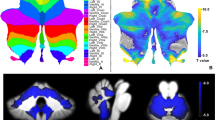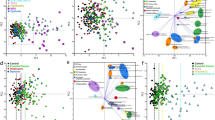Abstract
Although “cerebellar ataxia” is often used in reference to a disease process, presumably there are different underlying pathogenetic mechanisms for different subtypes. Indeed, spinocerebellar ataxia (SCA) types 2 and 6 demonstrate complementary phenotypes, thus predicting a different anatomic pattern of degeneration. Here, we show that an unsupervised classification method, based on principal component analysis (PCA) of cerebellar shape characteristics, can be used to separate SCA2 and SCA6 into two classes, which may represent disease-specific archetypes. Patients with SCA2 (n = 11) and SCA6 (n = 7) were compared against controls (n = 15) using PCA to classify cerebellar anatomic shape characteristics. Within the first three principal components, SCA2 and SCA6 differed from controls and from each other. In a secondary analysis, we studied five additional subjects and found that these patients were consistent with the previously defined archetypal clusters of clinical and anatomical characteristics. Secondary analysis of five subjects with related diagnoses showed that disease groups that were clinically and pathophysiologically similar also shared similar anatomic characteristics. Specifically, Archetype #1 consisted of SCA3 (n = 1) and SCA2, suggesting that cerebellar syndromes accompanied by atrophy of the pons may be associated with a characteristic pattern of cerebellar neurodegeneration. In comparison, Archetype #2 was comprised of disease groups with pure cerebellar atrophy (episodic ataxia type 2 (n = 1), idiopathic late-onset cerebellar ataxias (n = 3), and SCA6). This suggests that cerebellar shape analysis could aid in discriminating between different pathologies. Our findings further suggest that magnetic resonance imaging is a promising imaging biomarker that could aid in the diagnosis and therapeutic management in patients with cerebellar syndromes.




Similar content being viewed by others

References
Manto M-U, Pandolfo M. The cerebellum and its disorders. Cambridge, UK: Cambridge University; 2002.
Perlman S. Evaluation and management of ataxic disorders. An overview for physicians. Minneapolis: National Ataxia Foundation; 2007.
Ying SH, Choi SI, Lee M, Perlman SL, Baloh RW, Toga AW, et al. Relative atrophy of the flocculus and ocular motor dysfunction in SCA2 and SCA6. Ann N Y Acad Sci. 2005;1039:430–5.
Jung BC, Choi SI, Du AX, Cuzzocreo JL, Ying HS, Landman BA, et al. MRI shows a region-specific pattern of atrophy in spinocerebellar ataxia type 2. Cerebellum [Internet]. 18 Aug 2011 [cited 11 Oct 2011]. Available from: http://www.ncbi.nlm.nih.gov/pubmed/21850525.
Subramony SH, May W, Lynch D, Gomez C, Fischbeck K, Hallett M, et al. Measuring Friedreich ataxia: interrater reliability of a neurologic rating scale. Neurology. 2005;64(7):1261–2.
Ying SH, Choi SI, Perlman SL, Baloh RW, Zee DS, Toga AW. Pontine and cerebellar atrophy correlate with clinical disability in SCA2. Neurology. 2006;66(3):424–6.
Schmahmann JD. MRI atlas of the human cerebellum. San Diego: Academic Press; 2000.
Buttner N, Geschwind D, Jen JC, Perlman S, Pulst SM, Baloh RW. Oculomotor phenotypes in autosomal dominant ataxias. Arch Neurol. 1998;55(10):1353–7.
Schulz JB, Borkert J, Wolf S, Schmitz-Hübsch T, Rakowicz M, Mariotti C, et al. Visualization, quantification and correlation of brain atrophy with clinical symptoms in spinocerebellar ataxia types 1, 3 and 6. Neuroimage. 2010;49(1):158–68.
Marzban H, Chung S-H, Pezhouh MK, Feirabend H, Watanabe M, Voogd J, et al. Antigenic compartmentation of the cerebellar cortex in the chicken (Gallus domesticus). J Comp Neurol. 2010;518(12):2221–39.
Kawamura K, Hashikawa T. Projections from the pontine nuclei proper and reticular tegmental nucleus onto the cerebellar cortex in the cat. An autoradiographic study. J Comp Neurol. 1981;201(3):395–413.
Voogd J, Barmack NH. Oculomotor cerebellum. Prog Brain Res. 2006;151:231–68.
Glickstein M, Gerrits N, Kralj-Hans I, Mercier B, Stein J, Voogd J. Visual pontocerebellar projections in the macaque. J Comp Neurol. 1994;349(1):51–72.
Eisenman LM, Noback CR. The ponto-cerebellar projection in the rat: differential projections to sublobules of the uvula. Exp Brain Res. 1980;38(1):11–7.
Brodal A, Hoddevik GH. The pontocerebellar projection of the uvula in the cat. Exp Brain Res. 1978;32(1):105–16.
Mower G, Gibson A, Robinson F, Stein J, Glickstein M. Visual pontocerebellar projections in the cat. J Neurophysiol. 1980;43(2):355–66.
Gerrits NM, Epema AH, Voogd J. The mossy fiber projection of the nucleus reticularis tegmenti pontis to the flocculus and adjacent ventral paraflocculus in the cat. Neuroscience. 1984;11(3):627–44.
Robinson FR, Cohen JL, May J, Sestokas AK, Glickstein M. Cerebellar targets of visual pontine cells in the cat. J Comp Neurol. 1984;223(4):471–82.
Akaogi K. Afferent projections to the nodulus in the cat. II. Mossy fiber projections. Nippon Jibiinkoka Gakkai Kaiho. 1994;97(1):12–9.
Brodal P. Further observations on the cerebellar projections from the pontine nuclei and the nucleus reticularis tegmenti pontis in the rhesus monkey. J Comp Neurol. 1982;204(1):44–55.
Liu J, Tang T-S, Tu H, Nelson O, Herndon E, Huynh DP, et al. Deranged calcium signaling and neurodegeneration in spinocerebellar ataxia type 2. J Neurosci. 2009;29(29):9148–62.
Chen X, Tang T-S, Tu H, Nelson O, Pook M, Hammer R, et al. Deranged calcium signaling and neurodegeneration in spinocerebellar ataxia type 3. J Neurosci. 2008;28(48):12713–24.
Rajakulendran S, Schorge S, Kullmann DM, Hanna MG. Dysfunction of the Ca(V)2.1 calcium channel in cerebellar ataxias. F1000 Biol Rep [Internet]. 2010 [cited 1 Jun 2011]; 2. Available from: http://www.ncbi.nlm.nih.gov/pubmed/20948794.
Acknowledgements
This work was supported by the Arnold-Chiari Foundation, the Robin Zee Fund, the Dana Foundation Program for Brain and Immuno-Imaging, the Research to Prevent Blindness Core Grant, and the National Institutes of Health (grant numbers 1K23EY015802, 5T32DC00023, 5T32MH019950, 5T32GM007057, R01 EY01849, 1R01NS056307, R01NS054255, 5RC1NS068897, 5R01EY019347, and 5R21NS059830). We would also like to thank Mimi Lee and Elizabeth Murray for their technical assistance.
Conflicts of interest
There is no financial interest to disclose.
Author information
Authors and Affiliations
Corresponding author
Additional information
Statistical analysis was completed by B.C.J. and S.H.Y. (from The Johns Hopkins University).
Rights and permissions
About this article
Cite this article
Jung, B.C., Choi, S.I., Du, A.X. et al. Principal Component Analysis of Cerebellar Shape on MRI Separates SCA Types 2 and 6 into Two Archetypal Modes of Degeneration. Cerebellum 11, 887–895 (2012). https://doi.org/10.1007/s12311-011-0334-6
Published:
Issue Date:
DOI: https://doi.org/10.1007/s12311-011-0334-6



